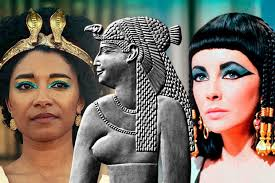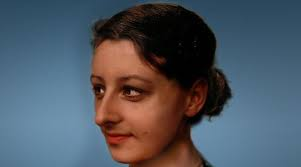Introduction
Cleopatra real face-Cleopatra VII, the last active ruler of the Ptolemaic Kingdom of Egypt, remains one of history’s most captivating figures. Her life, marked by political acumen and romantic liaisons with Julius Caesar and Mark Antony, has been extensively documented. However, the true appearance of Cleopatra has been a subject of intrigue and speculation. This article delves into the available evidence and recent discoveries to shed light on what Cleopatra may have looked like.

Historical Depictions
Ancient representations of Cleopatra are scarce, and those that exist are often stylized or idealized. The most notable artifacts include:
Berlin Bust: Housed in the Altes Museum in Berlin, this marble bust is widely believed to depict Cleopatra. It portrays her wearing a royal diadem, with ringlets framing her face and a “melon” hairstyle gathered into a bun. Her almond-shaped eyes and prominent nose are evident, suggesting features that reflect intelligence and charm.
Coins and Sculptures: Contemporary coins and sculptures from Cleopatra’s reign often depict her with a hooked nose and a strong jawline, features that were considered regal and authoritative in Ptolemaic Egypt. These portrayals emphasize her Hellenistic heritage and royal status.
Facial Reconstructions
Advancements in technology have enabled researchers to attempt facial reconstructions of Cleopatra based on available artifacts:
Artistic Reconstructions: Using the Berlin Bust and other artifacts, artists have created reconstructions that depict Cleopatra with a strong, regal appearance, highlighting her Hellenistic features. These reconstructions aim to provide a more lifelike representation of the queen.
3D Modeling: Some researchers have employed 3D modeling techniques to reconstruct Cleopatra’s face, offering a speculative glimpse into her appearance. These models often emphasize her prominent nose and strong jawline, consistent with ancient depictions.
Recent Discoveries
In December 2024, a significant archaeological discovery was made near Cleopatra’s alleged tomb at Taposiris Magna:
Marble Statue: A white marble statue was unearthed, depicting a woman wearing a royal crown. Some experts believe this statue represents Cleopatra VII, while others suggest it could be a Ptolemaic princess. The statue’s features, including the nose and chin, align with those seen in contemporary representations of Cleopatra. citeturn0news19
Cultural Interpretations
Throughout history, Cleopatra’s image has been shaped by cultural narratives and artistic interpretations:
Roman Propaganda: Roman portrayals often emphasized her allure and seductiveness, focusing on her relationships with Julius Caesar and Mark Antony. These depictions were more about political narrative than accurate representation.
Modern Media: Films and literature have portrayed Cleopatra in various lights, often emphasizing her beauty and charisma. These portrayals are influenced by contemporary standards and may not accurately reflect her true appearance.
While definitive evidence of Cleopatra’s exact appearance remains elusive, existing artifacts and recent discoveries provide valuable insights. The Berlin Bust and the newly uncovered marble statue offer glimpses into her physical features, suggesting a woman of strong character and regal bearing. However, without more concrete evidence, the true face of Cleopatra continues to be a subject of scholarly debate and public fascination.
Faqs
What did Cleopatra look like?
Cleopatra VII, the last active ruler of the Ptolemaic Kingdom of Egypt, is often depicted as a woman of exceptional beauty and charm. However, historical evidence suggests that her allure was more likely due to her intelligence, charisma, and political acumen than her physical appearance. Artifacts such as coins and sculptures provide some insights into her features. For instance, many coins depict her with an aquiline nose and a jutting chin, wearing her curly hair in the popular “melon” style of the time, tied in a bun at the base of her skull. citeturn0search5
Are there any surviving images of Cleopatra?
Yes, there are several surviving images of Cleopatra, primarily in the form of coins and sculptures. One notable example is a marble bust housed in the Berlin Altes Museum, which is widely agreed to depict Cleopatra. This bust shows her wearing a royal diadem and her face framed by ringlets of curly hair.
What is the recent discovery related to Cleopatra’s appearance?
In December 2024, archaeologists uncovered a marble bust in the ancient Taposiris Magna temple near Alexandria, Egypt. The bust is believed by some experts to depict Cleopatra VII, though others suggest it might represent a different Ptolemaic princess. This discovery has sparked debate among scholars regarding its identification. citeturn0news18
How accurate are facial reconstructions of Cleopatra?
Facial reconstructions of Cleopatra are speculative and based on available artifacts, such as coins and sculptures. These reconstructions aim to provide a visual approximation of her appearance but cannot be considered definitive. For example, a 3D facial reconstruction based on a bust from the Berlin Altes Museum offers one interpretation of her features.
Did Cleopatra have any distinctive physical features?
Historical accounts and artistic depictions suggest that Cleopatra had an aquiline nose and a jutting chin. Her hair was often styled in the “melon” fashion, divided into segments and tied in a bun at the base of her skull. These features are commonly seen in contemporary coins and sculptures.
How do historians determine Cleopatra’s appearance?
Historians and archaeologists analyze surviving artifacts, such as coins, sculptures, and busts, to infer Cleopatra’s appearance. These artifacts provide visual representations that, while not definitive, offer insights into how she was portrayed during her reign.
Are there any modern interpretations of Cleopatra’s appearance?
Yes, modern artists and researchers have created facial reconstructions of Cleopatra based on available artifacts. These reconstructions vary, reflecting the speculative nature of such endeavors. For instance, a 3D facial reconstruction based on a bust from the Berlin Altes Museum offers one interpretation of her features.
What do recent archaeological findings reveal about Cleopatra?
Recent archaeological discoveries, such as the bust found in the Taposiris Magna temple, continue to shed light on Cleopatra’s era. While these findings provide valuable context, they do not offer definitive evidence of her physical appearance. citeturn0news18
How do Cleopatra’s depictions compare to other historical figures?
Like many historical figures, Cleopatra’s appearance has been subject to artistic interpretation and embellishment. While some depictions emphasize her beauty, others highlight her intelligence and political prowess. The lack of definitive contemporary portraits means that her true appearance remains a subject of speculation.
Why is there so much interest in Cleopatra’s appearance?
Cleopatra’s life and reign have captivated historians, artists, and the public for centuries. Her relationships with Julius Caesar and Mark Antony, her political strategies, and her portrayal in literature and film have all contributed to the enduring fascination with her image. Understanding her appearance offers a glimpse into the historical and cultural context of her time.
To read more click here

Leave a Reply